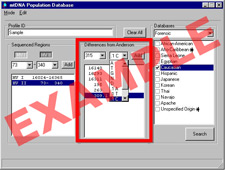Home | Glossary | Resources | Help | Contact Us | Course Map
Archival Notice
This is an archive page that is no longer being updated. It may contain outdated information and links may no longer function as originally intended.
The use of mtDNA as a forensic tool evolved from its role in the study of human history and human disease. mtDNA analysis solved several historical mysteries, such as the identification of the Czar's remains in Russia and the skeleton of Jesse James. Anthropologists have recovered mtDNA from Neanderthal skeletons at least 30,000 years old.
This type of forensic analysis routinely aids in identification of war dead, including a serviceman who served in Vietnam now buried in the Tomb of the Unknown Soldier. It also augmented STR testing of remains from the World Trade Center attacks (9/11/01).
Additional Online Courses
- What Every First Responding Officer Should Know About DNA Evidence
- Collecting DNA Evidence at Property Crime Scenes
- DNA – A Prosecutor’s Practice Notebook
- Crime Scene and DNA Basics
- Laboratory Safety Programs
- DNA Amplification
- Population Genetics and Statistics
- Non-STR DNA Markers: SNPs, Y-STRs, LCN and mtDNA
- Firearms Examiner Training
- Forensic DNA Education for Law Enforcement Decisionmakers
- What Every Investigator and Evidence Technician Should Know About DNA Evidence
- Principles of Forensic DNA for Officers of the Court
- Law 101: Legal Guide for the Forensic Expert
- Laboratory Orientation and Testing of Body Fluids and Tissues
- DNA Extraction and Quantitation
- STR Data Analysis and Interpretation
- Communication Skills, Report Writing, and Courtroom Testimony
- Español for Law Enforcement
- Amplified DNA Product Separation for Forensic Analysts


